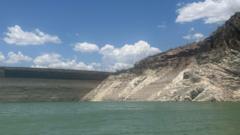After over two years without adequate rainfall, the community of San Francisco de Conchos in Chihuahua, Mexico, finds itself in dire need of water. Residents gather along Lake Toronto, the region's crucial reservoir, enduring extreme heat and praying for deliverance from the drought. Lake levels have plummeted, leaving the reservoir at only 14% capacity.
The discourse is further complicated by a longstanding water-sharing agreement from 1944, mandating Mexico provide the US with 430 million cubic meters of water annually from the Rio Grande. However, Mexico has been unable to fulfill its obligations, igniting a heated debate between the two nations and providing leverage for US politicians like former President Trump, who recently accused Mexico of "stealing" water, threatening tariffs if Mexico doesn't comply.
On the ground, farmers like Brian Jones in Texas, who have already faced crop reductions due to limited irrigation, demand what they deem their fair share while feeling frustrated over alleged "water hoarding" by Mexican farmers. On the other hand, Mexican farmers argue that they have their needs to meet first and can’t send any excess water during this drought.
Echoing the urgency for water efficiency, many Mexican farmers still rely on traditional flooding methods, raising concerns among Texans about agricultural wastefulness. Some, like Jaime Ramirez, advocate for modern practices that conserve water. Yet many in Mexico warn about the existential threat they face if rain continues to elude them.
As discussions continue over the outdated treaty, both sides express urgency for a solution, hoping for rain, yet also recognizing the need for sustainable changes. With deepening conflicts over water access, the situation in the region underscores the dire consequences of climate change and highlights the fragility of cross-border relationships in times of need.




















